英语作文写作课课件
- 格式:pptx
- 大小:1.30 MB
- 文档页数:24
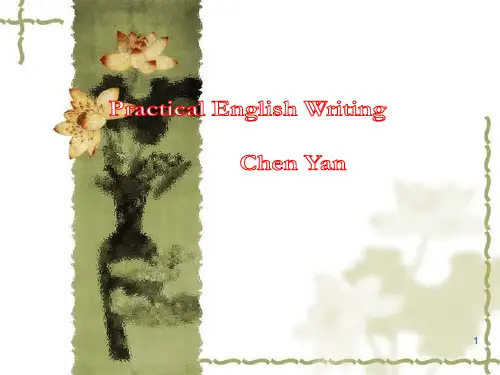
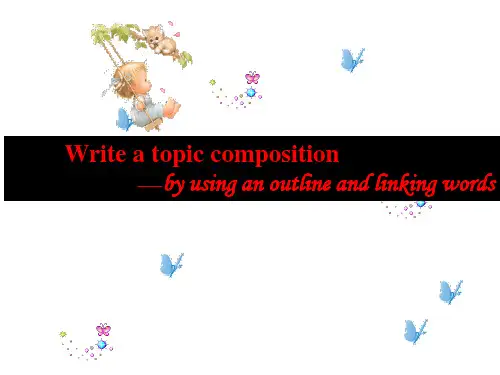
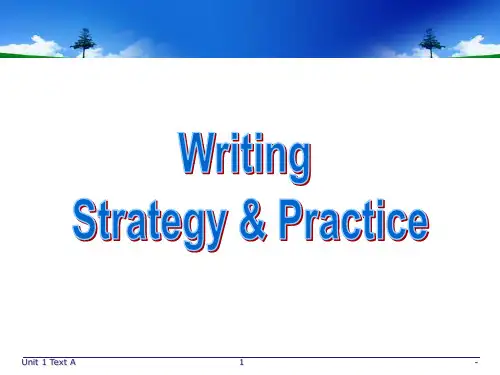
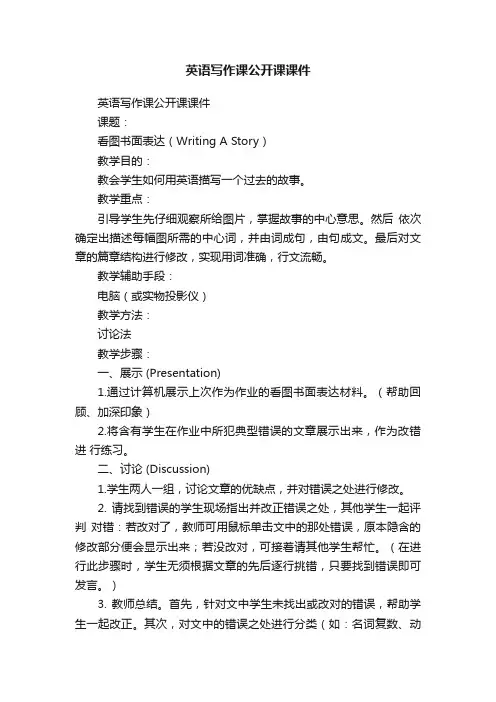
英语写作课公开课课件英语写作课公开课课件课题:看图书面表达(Writing A Story)教学目的:教会学生如何用英语描写一个过去的故事。
教学重点:引导学生先仔细观察所给图片,掌握故事的中心意思。
然后依次确定出描述每幅图所需的中心词,并由词成句,由句成文。
最后对文章的篇章结构进行修改,实现用词准确,行文流畅。
教学辅助手段:电脑(或实物投影仪)教学方法:讨论法教学步骤:一、展示 (Presentation)1.通过计算机展示上次作为作业的看图书面表达材料。
(帮助回顾、加深印象)2.将含有学生在作业中所犯典型错误的文章展示出来,作为改错进行练习。
二、讨论 (Discussion)1.学生两人一组,讨论文章的优缺点,并对错误之处进行修改。
2. 请找到错误的学生现场指出并改正错误之处,其他学生一起评判对错:若改对了,教师可用鼠标单击文中的那处错误,原本隐含的修改部分便会显示出来;若没改对,可接着请其他学生帮忙。
(在进行此步骤时,学生无须根据文章的先后逐行挑错,只要找到错误即可发言。
)3. 教师总结。
首先,针对文中学生未找出或改对的错误,帮助学生一起改正。
其次,对文中的错误之处进行分类(如:名词复数、动词时态、介词等),引起学生的重视。
三、展示 (Presentation)通过计算机展示给学生一篇新的看图书面表达材料。
要求学生仔细观察所给图片,掌握故事的中心意思。
四、讨论 (Discussion)1.学生两人一组(必要时可变为四人一组,增强协作性),针对每幅图进行讨论,并确定描述每幅图的中心词。
2. 按图片的先后顺序,分别要求几组学生将他们的讨论结果告诉大家,由大家一起来讨论用词是否恰当及如何改正。
同时,教师将这些词按图片顺序依次输入计算机,展示给大家(也可通过实物投影仪展示)。
五、练习 (Practice)要求学生参考中心词,写出描述每幅图的一两个句子,输入计算机(若通过实物投影仪展示,可写在纸上)。
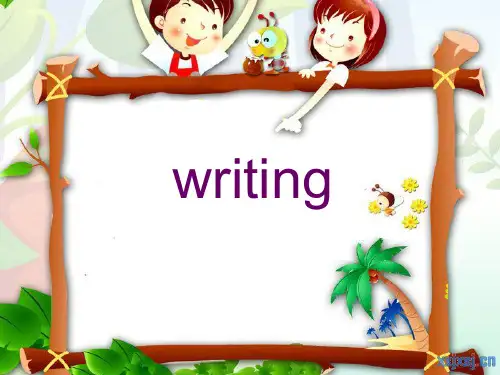




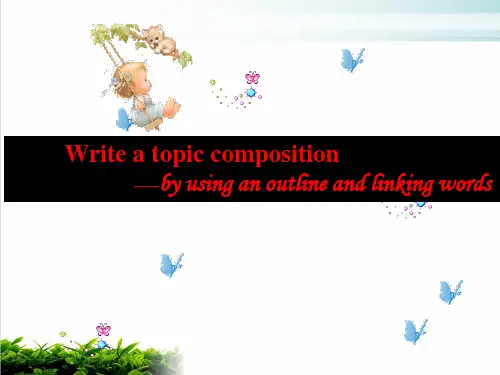

初中英语作文写作课优秀课件目录CATALOGUE •Course Introduction andObjectives•Fundamentals of Writing•Writing skills and methods•Common Theme WritingGuidelines•Appreciation and Analysis ofMasterpieces•Writing training andimprovement01CATALOGUECourse Introduction andObjectivesThe Importance of Middle School English Composition•Improving students' comprehensive English proficiency: Throughwriting training, students can better grasp language elements such asvocabulary, grammar, and sentence structures, and improve theiroverall English proficiency.•Developing students' cross-cultural communication skills: Englishwriting is one of the important means of cross-culturalcommunication. Through writing training, students can betterunderstand the culture and thinking patterns of English speakingcountries, and improve their cross-cultural communication abilities.•To lay a foundation for students' future learning and work: GoodEnglish writing ability is an important foundation for students' futurelearning and work, which can provide more opportunities for theirfurther education and career development.Course objectives and requirementsKnowledge objectiveTo master the basic knowledge and skills of English writing, including writing process, article structure,paragraph development, sentence structure changes, etc.Ability objectiveTo independently complete an English article with clear structure, rigorous logic, and fluent language, andpossess certain critical thinking and innovative abilities.Emotional goalTo cultivate students' interest and enthusiasm for English writing, improve their self-learningability and collaborative spirit.Course arrangement and scheduleCourse arrangementThis course is divided into 10 class hours, each lasting 45 minutes. The coursecontent includes explanation of basic writing knowledge, analysis of sampleessays, writing practice, and homework review.Class timeOnce a week, the specific time will be arranged according to the student'sschedule and actual situation.Teaching methodAdopting a combination of online and offline methods, providing coursewareand teaching videos online, and conducting face-to-face tutoring and Q&Aoffline.02CATALOGUE Fundamentals of WritingVocabulary accumulation and application•Positive vocabulary and negative vocabulary: Positive vocabulary refersto words that can directly express the author's intention in the article,while negative vocabulary refers to words that cannot directly expressthe intention but can increase the richness and readability of thearticle.•Semantic analysis and accurate word usage: In English, many wordshave similar meanings, but their usage scenarios and contexts aredifferent. Therefore, when writing, it is important to pay attention toword meaning analysis and choose the most accurate vocabulary toexpress one's thoughts.•Phrases and idioms: There are many fixed phrases and idioms inEnglish, and mastering these expressions can make the article moreauthentic and natural.Sentence Structure and Changes•Simple sentences, compound sentences, and compound sentences:Simple sentences only contain one subject and one predicate; Parallelsentences are composed of two or more simple sentences connectedby parallel conjunctions; A compound sentence contains a main clauseand one or more subordinate clauses.•Sentence pattern transformation and expansion: Through sentencepattern transformation, declarative sentences can be transformed intointerrogative sentences, exclamation sentences, etc., increasing thediversity and expressive power of the article. At the same time,sentence components can also be expanded, such as addingattributives, adverbials, etc., to make the sentence more specific andvivid.There are multiple tenses and voices in English, and using them correctly can make the article more accurate and fluent.The subject and predicate mustbe consistent in person andnumber, otherwise it will lead togrammar errors.Articles, pronouns, andprepositions play importantconnecting roles in English. Usingthese vocabulary correctly canmake the article more coherentand clear. Meanwhile, it is alsoimportant to avoid commonusage errors.Tense and voice Subject verbconsistency Articles, pronouns, and prepositionsGrammar rules and common errors03CATALOGUEWriting skills and methods03Conceptual contentBased on the theme, develop associations, and conceptualize the content and key points of the article.01Carefully review the questioncarefully read the question, understand its meaning, and clarify the writing requirements and limitations.02Determine the themeBased on the requirements of the title, determine the theme and central idea of the article.Topic review and conceptionArticle structure and layoutReasonably arrange paragraphs01Based on the content of the article, arrange paragraphsreasonably to make the article clear in hierarchy.Highlight topic sentences02Set topic sentences at the beginning or end of each paragraphto clarify the central idea of the paragraph.Pay attention to transitions03Use transitional words or phrases between paragraphs to makethe article coherent and natural.Language expression and rhetoric•Accurate wording: Choose appropriate vocabulary to express ideasand avoid using obscure or overly simple words.•Diverse sentence structures: Use different sentence structures toexpress ideas, such as simple sentences, compound sentences, etc., toenhance the expressive power of the article.•Using rhetoric: Use appropriate rhetorical devices such as metaphors,personification, and parallelism to make the article more vivid andvivid.•Pay attention to grammar and spelling: avoid grammar and spellingerrors, and maintain the accuracy and standardization of the article.04CATALOGUE Common Theme WritingGuidelinesNarrative Writing•Select a theme and plot: Choose an interesting story theme and planthe plot development, including the cause, process, and outcome.•Shaping character images: By describing the appearance, personality,behavior, and other aspects of characters, vivid character images arecreated.•Pay attention to detail description: Use vivid details to help readersbetter understand and feel the story context.•Reasonable arrangement of narrative sequence: Different narrativemethods such as sequential, reverse, or interlude can be used to makethe story more engaging.Choose a familiar objectof explanation, such as an object, event,phenomenon, etc., and provide a detailedintroduction and explanation.Clearlyexplain the objectCollect and explain information andinformation related to the target through channels such as books and theinternet.Collect relevant informationOrganize the content ofthe article in an organized manner according to differentexplanation orders suchas time order, spatial order, or logical order.Arrange explanation orderUsing different methodssuch as definition,classification, comparison, and examples to make the article moreaccessible and understandable.Usingexplanatory methodsExpository writingargumentative writing•Identify arguments and evidence: Choose a controversial topic, clarifyyour viewpoint and stance, and prepare supporting evidence tosupport the argument.•Reasonable arrangement of argumentation structure: Differentargumentation structures such as total score, listing themes, andfinding several parallel viewpoints to discuss the themes can be usedto make the article clear and organized.•Using argumentation methods: using different argumentationmethods such as factual argumentation, rational argumentation, andcomparative argumentation to enhance the persuasiveness of thearticle.•Pay attention to language use: Use accurate and concise language toexpress opinions, and avoid using words that are too absolute orvague.05CATALOGUE Appreciation and Analysis of MasterpiecesExhibition of excellent works by studentsWork 1"My Favorite Teacher"Work 2A Memorable DayWork 3"The Power of Friendship"Teacher comments and suggestions•Comment on work one: The article has a clear structure and fluentlanguage, showcasing the excellent qualities of the teacher throughspecific examples, expressing the author's love and gratitude towardsthe teacher. Suggest adding some detailed descriptions to make thecharacter image more vivid.•Commentary on Work 2: The article features novel material selectionand vivid narration, showcasing the author's love and optimisticattitude towards life by recounting interesting events that happenedduring the day. Suggest refining the language expression to enhancethe infectiousness of the article.•Comment on work three: The article has a profound meaning and clearviewpoint. By discussing the power of friendship, it expresses theauthor's appreciation and admiration for friendship. It is suggested toadd some specific examples during the argumentation process tomake the viewpoint more convincing.Interactive session: Student self-evaluation and peer evaluation•Self evaluation: I believe that I have a certain foundation in writing andcan express my thoughts fluently. But there is still room forimprovement in the selection of materials and ideas, and moreattention needs to be paid to observing and thinking about life.•Mutual evaluation one: I think his works have concise language andclear expression, but there are still shortcomings in detail descriptionand emotional expression. I hope he can pay more attention to detailsand emotional presentation in his writing.•Mutual evaluation two: I think her works have novel material selectionand unique perspectives, but in the process of argumentation, thereare some that are too simplistic and one-sided. I hope she can addsome specific examples and data support in the argument to make theviewpoint more convincing.06CATALOGUE Writing training and improvementClassroom timed writing exercisesStrictly set the timein a simulated exam environment, students are required to complete theiressays within the specified time.Diversity of topic selectionProvide different types of questions to expose students to and practice variousgenres and themes.On the spot reviewProvide real-time feedback on students' compositions, pointing out theirstrengths and weaknesses, and providing suggestions for improvement.Suggestions for independent training after classPersist in writingEncourage students to develop the habit of writingevery day, such as writing diaries, weekly notes, oressays.Expand readingRecommend English original works or articlessuitable for middle school students to read, broadentheir horizons, and accumulate materials.Reflection and revisionGuide students to reflect and revise their owncompositions, and improve their self correctionability.RegularassessmentConduct a formal writing assessment at regular intervals to assess students' learning outcomes.PersonalizedfeedbackProvide specific feedback andsuggestions for each student'sessay to help them identify theirshortcomings.Display andCommunicationSelect excellent compositions fordisplay and communication,allowing students to learn fromeach other and progress together.010203 Regular evaluation and feedbackTHANKS感谢观看。
English Composition Class SlidesSlide1:Introduction to English CompositionWelcome to the English Composition ClassObjective:To improve writing skills and express thoughts clearly in English Importance of Composition:Effective communication,academic success,professional growthSlide2:Elements of a Good CompositionClear Topic SentenceSupporting DetailsLogical OrganizationConcluding SentenceAppropriate Word ChoiceCorrect Grammar and PunctuationSlide3:Understanding the AudienceWho is your reader?What do they know about the topic?How can you engage your audience?Slide4:Brainstorming IdeasFree Writing:Write down everything that comes to mindMind Mapping:Visualize ideas and their connectionsClustering:Group related ideas togetherSlide5:Outlining the CompositionIntroduction:Introduce the topic and thesis statementBody Paragraphs:Develop main points with examples and evidence Conclusion:Summarize main points and restate thesisSlide6:Writing the IntroductionHook:Grab the readers attentionBackground Information:Provide contextThesis Statement:Clearly state the main argument or purposeSlide7:Developing Body ParagraphsTopic Sentence:Clearly state the main ideaSupporting Details:Provide examples,facts,or quotes Analysis:Explain the significance of the detailsTransition:Connect to the next paragraphSlide8:Crafting the ConclusionRestate Thesis:Reinforce the main argumentSummarize Main Points:Briefly review the body paragraphs Closing Thought:End with a memorable statement or a call to actionSlide9:Revising and EditingRevising:Reorganize ideas,clarify thoughts,improve coherence Editing:Check for grammar,spelling,punctuation,and styleSlide10:Peer Review and FeedbackShare your composition with a peerProvide constructive feedback:What works well?What could be improved? Incorporate feedback to refine your writingSlide11:Common Writing MistakesRunon Sentences:Sentences that are too long and lack proper punctuation Fragments:Incomplete sentencesDangling Modifiers:Phrases that dont clearly attach to the main sentence SubjectVerb Agreement:Ensuring the subject and verb match in numberSlide12:Using Dictionaries and ThesaurusDictionary:Look up word meanings,spellings,and pronunciations Thesaurus:Find synonyms and related words to enrich vocabularySlide13:Plagiarism and Academic IntegrityUnderstanding Plagiarism:Using someone elses work without proper attribution Citing Sources:Properly crediting the original authorImportance of Academic Integrity:Upholding honesty and trust in academic workSlide14:Final ThoughtsPractice makes perfect:Write regularly to improveSeek feedback:Learn from others to grow as a writerEnjoy the process:Writing is a creative and rewarding experienceSlide15:Resources for Further LearningRecommended Reading:Books and articles on writingOnline Tools:Grammar checkers,writing prompts,and writing communities Writing Workshops:Opportunities to learn and practice in a group settingFeel free to add interactive elements such as quizzes,writing exercises,or group discussions to engage your students and make the lesson more dynamic.。